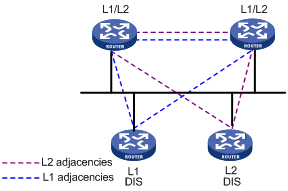IS-IS network type
Network type
IS-IS supports the following network types:
Broadcast network, such as Ethernet and Token-Ring
Point-to-point network, such as PPP and HDLC
DIS and pseudonodes
On an IS-IS broadcast network, a router is elected as the Designated Intermediate System (DIS).
The Level-1 and Level-2 DISs are elected. You can assign different priorities to different level DIS elections. The higher a router's priority is, the more likely the router becomes the DIS. If multiple routers with the same highest DIS priority exist, the one with the highest SNPA (Subnetwork Point of Attachment) address (MAC address on a broadcast network) will be elected. A router can be the DIS for different levels.
IS-IS DIS election differs from OSPF DIS election in the following ways:
A router with priority 0 can also participate in the DIS election.
When a router is added to the network and becomes the new DIS, an LDP flooding process is triggered.
As shown in Figure 52, the same level routers on a network, including non-DIS routers, establish adjacencies with each other.
Figure 52: DIS in the IS-IS broadcast network
The DIS creates and updates pseudonodes, as well as generates their LSPs, to describe all routers on the network.
A pseudonode represents a virtual node on the broadcast network. It is not a real router. In IS-IS, it is identified by the system ID of the DIS and a one-byte Circuit ID (a non zero value).
Using pseudonodes can reduce the resources consumed by SPF and simplify network topology.
![[NOTE: ]](images/note.png) | NOTE: On IS-IS broadcast networks, all routers are adjacent with each other. However, the DIS is responsible for the synchronization of their LSDBs. | |
